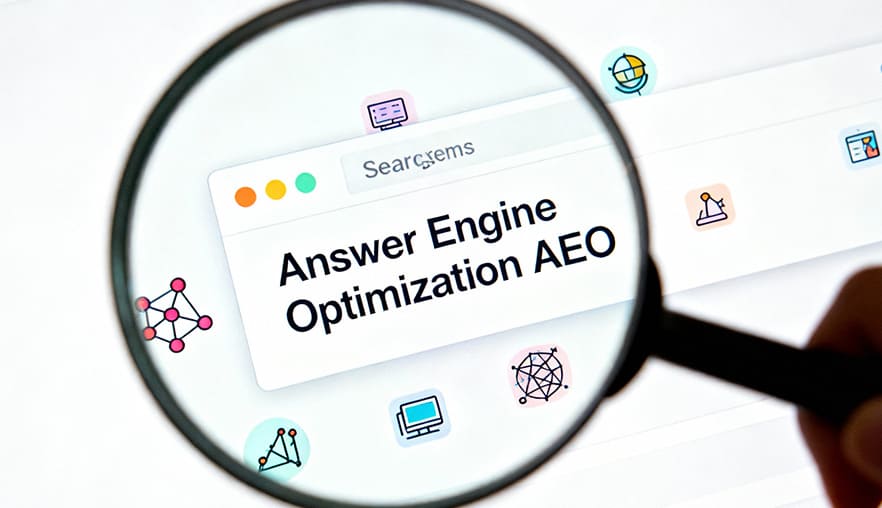Introduction to Answer Engine Optimization
The rapid rise of conversational agents, voice assistants, and generative AI has changed how people search for information. Platforms like ChatGPT, Perplexity AI, Google’s Search Generative Experience (SGE), and Microsoft Copilot aim to deliver direct answers rather than a list of links. Answer Engine Optimization (AEO) is the practice of structuring your content so that these answer engines can easily find, understand, and cite it. AEO complements traditional SEO; rather than focusing solely on ranking in organic results, it prioritizes being referenced as the authoritative source in AI-generated answers.
AEO relies on natural-language queries and structured data to provide concise, trustworthy answers that can be read aloud by voice assistants and synthesized by AI models.
How AEO Differs from Traditional SEO
While both AEO and SEO aim to improve visibility, their approaches and success metrics differ. Traditional SEO concentrates on keyword-driven ranking in search engine results pages, encouraging users to click through to a website. AEO, by contrast, seeks to appear in featured snippets, voice assistant responses, and AI summaries where users might not click at all.
| Aspect | Traditional SEO | Answer Engine Optimization (AEO) |
|---|---|---|
| Primary goal | Increase rankings and organic traffic through keywords and backlinks | Earn citations and direct answers in AI-generated results, voice assistants, and zero-click panels |
| User input | Short, keyword-focused queries | Conversational questions and long-tail phrases |
| Results format | List of blue links | Single synthesized answer often accompanied by citations |
| Content focus | Comprehensive pages optimized for a primary keyword | Structured content (FAQs, lists, tables) designed to be quoted |
| Success metrics | Rankings, impressions, and clicks | Number of featured snippets, AI citations, and share of voice |
| Technical focus | Metadata, indexability, Core Web Vitals | Schema markup, conversational structure, and AI crawler readiness |
SEO lays the foundation for AEO through crawlability, high-quality content, and authority signals. However, AEO extends optimization to answer engines by focusing on semantic context, question-answer formats, and structured data.
Why AEO Matters in Modern Search
- Explosion of AI platforms and voice assistants. OpenAI’s ChatGPT reportedly attracted about 400 million weekly users in 2025. Gartner predicts that by 2026, 25 % of organic traffic will shift to AI chatbots. Voice commerce is expected to reach US $80 billion, reflecting billions of digital voice assistants worldwide.
- Shift toward conversational queries. Roughly 15 % of Google searches each day are brand-new and question-based.
- Zero-click searches. More than 65 % of Google searches end without a click. Brands that appear in these answers retain visibility even when users don’t click through.
- AI citation and authority. Answer engines favor trustworthy sources and cite only a handful of pages. Earning a mention ensures exposure even without traffic passing through the site.
Key Elements of AEO
1. Structured Data and Schema Markup
Use Schema.org types such as FAQPage, HowTo, Product, and LocalBusiness to help AI models interpret entities and context.
2. Concise, Question-Focused Content
Write conversational, direct answers near the top of your content.
3. Semantic Markup and Natural Language
Use clear headings and conversational phrasing.
4. E-E-A-T (Expertise, Experience, Authority, Trust)
Demonstrate credibility through author bios, verified reviews, and transparent business details.
5. Off-Site Signals
Maintain consistent brand presence across social platforms, Q&A networks, and AI directories.
How Search Engines and AI Use AEO Content
Answer engines use NLP and large language models (LLMs) to interpret questions, break them into sub-queries, and synthesize answers. Pages with question-based headings, concise summaries, and schema markup are more likely to be selected or cited.
Best Practices for Implementing AEO
- Research user questions using tools like AnswerThePublic or People Also Ask.
- Structure your content for 40–60 word concise answers.
- Implement proper schema markup and validate it.
- Optimize for voice and multimodal search.
- Maintain fast load times, HTTPS security, and accessibility.
- Build authority with digital PR, reputable backlinks, and consistent branding.
- Track performance using analytics and specialized AEO trackers.
Tools and Platforms That Support AEO
Examples include Gauge, Profound, Evertune, Athena, Ahrefs Brand Radar, Semrush AI Toolkit, ProductRank.ai, Gumshoe, and Bluefish AI.
For research, AnswerThePublic, AlsoAsked, Surfer SEO, and MarketMuse help identify key questions and structure content.
Real-World Examples of AEO in Action
- Featured Snippet Win: A software firm created a structured FAQ and earned a featured snippet for “How does two-factor authentication work?”.
- Voice Assistant Recommendation: A travel company optimized content for conversational queries like “What’s the best time to visit Kyoto?” and became the preferred answer for voice assistants.
- Knowledge Panel Creation: A fintech added schema for its team and contact info, resulting in a branded knowledge panel.
- AI Chatbot Citation: A retailer’s sustainable packaging guide was cited in AI search results.
- E-commerce Boost: Adding product and FAQ schema increased organic visibility by 35 %.
- B2B SaaS Growth: Adding FAQ schema across 1,000+ pages boo
- sted impressions by over 9,000 %.
- Agency-Style Implementation: A digital marketing firm restructured its website with schema and natural-language headings; 10 % of new traffic came from AI citations.
Challenges and Limitations of AEO
- Limited tracking tools and unclear attribution
- Internal resistance or lack of resources
- Varying AI platform behaviors
- Rising content competition
- Rapidly evolving algorithms and voice search technologies
Future Trends in AEO and AI-Powered Search
- Personalized contextual answers
- Cross-platform search convergence
- Direct brand citations and semantic matching
- Growth of multimodal and voice search
- Regulatory transparency in AI citations
- New AEO-specific analytics and benchmarks
Conclusion
Answer Engine Optimization (AEO) represents the next era of search marketing. It expands traditional SEO into conversational, AI-powered experiences where users expect immediate, accurate responses.
Brands investing in structured data, concise question-focused content, and strong E-E-A-T signals will dominate AI-driven results, voice assistants, and generative search platforms.


